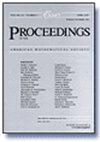On the 𝑝-rank of curves
IF 0.8
3区 数学
Q2 MATHEMATICS
引用次数: 0
Abstract
In this paper, we are concerned with the computations of the
论曲线的𝑝-rank
在本文中,我们关注两种不同情况下曲线 p p -rank 的计算。我们首先处理 n ≥ 2 \mathbf {P}^n \text { for } n\ge 2 的 P n 中的完全交集品种,并明确计算 Frobenius 对顶同调群的作用。在曲线和曲面的情况下,这些信息足以确定该变化是否普通。接下来,我们考虑更一般的曲面上的曲线,即 p g ( S ) = 0 = q ( S ) p_g(S) = 0 = q(S),如希尔泽布鲁赫曲面,并确定希尔泽布鲁赫曲面上曲线的 p p -rank。
本文章由计算机程序翻译,如有差异,请以英文原文为准。
求助全文
约1分钟内获得全文
求助全文
来源期刊
CiteScore
1.70
自引率
10.00%
发文量
207
审稿时长
2-4 weeks
期刊介绍:
All articles submitted to this journal are peer-reviewed. The AMS has a single blind peer-review process in which the reviewers know who the authors of the manuscript are, but the authors do not have access to the information on who the peer reviewers are.
This journal is devoted to shorter research articles (not to exceed 15 printed pages) in all areas of pure and applied mathematics. To be published in the Proceedings, a paper must be correct, new, and significant. Further, it must be well written and of interest to a substantial number of mathematicians. Piecemeal results, such as an inconclusive step toward an unproved major theorem or a minor variation on a known result, are in general not acceptable for publication. Longer papers may be submitted to the Transactions of the American Mathematical Society. Published pages are the same size as those generated in the style files provided for AMS-LaTeX.

 求助内容:
求助内容: 应助结果提醒方式:
应助结果提醒方式:


